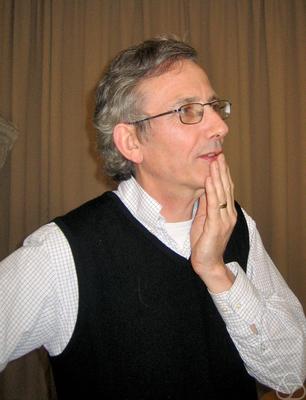In mathematics, in particular algebraic geometry, a moduli space is a geometric space whose points represent algebro-geometric objects of some fixed kind, or isomorphism classes of such objects. Such spaces frequently arise as solutions to classification problems: If one can show that a collection of interesting objects can be given the structure of a geometric space, then one can parametrize such objects by introducing coordinates on the resulting space. In this context, the term "modulus" is used synonymously with "parameter"; moduli spaces were first understood as spaces of parameters rather than as spaces of objects. A variant of moduli spaces is formal moduli. Bernhard Riemann first used the term "moduli" in 1857.

In mathematics, low-dimensional topology is the branch of topology that studies manifolds, or more generally topological spaces, of four or fewer dimensions. Representative topics are the structure theory of 3-manifolds and 4-manifolds, knot theory, and braid groups. This can be regarded as a part of geometric topology. It may also be used to refer to the study of topological spaces of dimension 1, though this is more typically considered part of continuum theory.
In mathematics and string theory, a conifold is a generalization of a manifold. Unlike manifolds, conifolds can contain conical singularities, i.e. points whose neighbourhoods look like cones over a certain base. In physics, in particular in flux compactifications of string theory, the base is usually a five-dimensional real manifold, since the typically considered conifolds are complex 3-dimensional spaces.
In mathematics, in the subfield of geometric topology, the mapping class group is an important algebraic invariant of a topological space. Briefly, the mapping class group is a certain discrete group corresponding to symmetries of the space.

Sir Simon Kirwan Donaldson is an English mathematician known for his work on the topology of smooth (differentiable) four-dimensional manifolds, Donaldson–Thomas theory, and his contributions to Kähler geometry. He is currently a permanent member of the Simons Center for Geometry and Physics at Stony Brook University in New York, and a Professor in Pure Mathematics at Imperial College London.
In mathematics, Thurston's classification theorem characterizes homeomorphisms of a compact orientable surface. William Thurston's theorem completes the work initiated by Jakob Nielsen.
In mathematics, the Teichmüller space of a (real) topological surface is a space that parametrizes complex structures on up to the action of homeomorphisms that are isotopic to the identity homeomorphism. Teichmüller spaces are named after Oswald Teichmüller.
In mathematics, and especially differential topology and gauge theory, Donaldson's theorem states that a definite intersection form of a compact, oriented, smooth manifold of dimension 4 is diagonalizable. If the intersection form is positive (negative) definite, it can be diagonalized to the identity matrix over the integers. The original version of the theorem required the manifold to be simply connected, but it was later improved to apply to 4-manifolds with any fundamental group.
In mathematics, specifically in topology, a pseudo-Anosov map is a type of a diffeomorphism or homeomorphism of a surface. It is a generalization of a linear Anosov diffeomorphism of the torus. Its definition relies on the notion of a measured foliation introduced by William Thurston, who also coined the term "pseudo-Anosov diffeomorphism" when he proved his classification of diffeomorphisms of a surface.

Clifford Henry Taubes is the William Petschek Professor of Mathematics at Harvard University and works in gauge field theory, differential geometry, and low-dimensional topology. His brother is the journalist Gary Taubes.
In mathematics, and more precisely in topology, the mapping class group of a surface, sometimes called the modular group or Teichmüller modular group, is the group of homeomorphisms of the surface viewed up to continuous deformation. It is of fundamental importance for the study of 3-manifolds via their embedded surfaces and is also studied in algebraic geometry in relation to moduli problems for curves.
In mathematical complex analysis, universal Teichmüller spaceT(1) is a Teichmüller space containing the Teichmüller space T(G) of every Fuchsian group G. It was introduced by Bers (1965) as the set of boundary values of quasiconformal maps of the upper half-plane that fix 0, 1, and ∞.

Richard Paul Winsley Thomas is a British mathematician working in several areas of geometry. He is a professor at Imperial College London. He studies moduli problems in algebraic geometry, and ‘mirror symmetry’—a phenomenon in pure mathematics predicted by string theory in theoretical physics.
In differential geometry, algebraic geometry, and gauge theory, the Kobayashi–Hitchin correspondence relates stable vector bundles over a complex manifold to Einstein–Hermitian vector bundles. The correspondence is named after Shoshichi Kobayashi and Nigel Hitchin, who independently conjectured in the 1980s that the moduli spaces of stable vector bundles and Einstein–Hermitian vector bundles over a complex manifold were essentially the same.
Clifford John Earle, Jr. was an American mathematician who specialized in complex variables and Teichmüller spaces.
Leon Armenovich Takhtajan is a Russian mathematical physicist of Armenian descent, currently a professor of mathematics at the Stony Brook University, Stony Brook, NY, and a leading researcher at the Euler International Mathematical Institute, Saint Petersburg, Russia.
Paul Stephen Aspinwall is a British theoretical physicist and mathematician, who works on string theory and also algebraic geometry.

Ralph Martin Kaufmann is a German mathematician working in the United States.
David Arends Gieseker is an American mathematician, specializing in algebraic geometry.

Michael Kapovich is a Russian-American mathematician.






